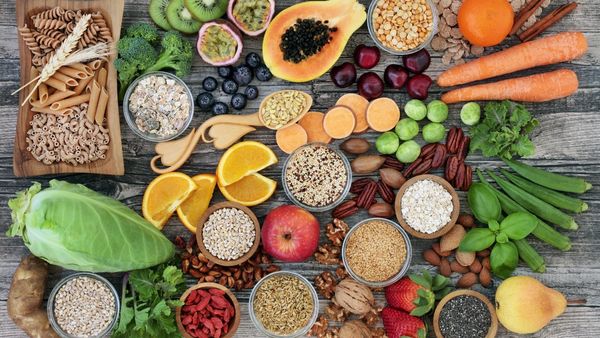A Fuel for Strength Series celebrating Nutrition Month
Before Frederick Banting and Charles Best discovered insulin in the early 1920s, the only way to manage diabetes was by observing a strict diet low in sugar and carbohydrates (carbs). Insulin was a game-changer; by helping to regulate blood sugar levels, injections of the hormone helped millions of people live much longer and much more comfortably. No wonder Banting was the first Canadian to win a Nobel Prize!
The discovery of insulin also improved our understanding of factors that prevent type 2 diabetes. This condition tends to strike later in life when the body can’t make or use enough of the insulin it produces naturally. As with type 1 diabetes, diet is key for the prevention and management of type 2 diabetes.
As a registered dietitian and the executive director of Diabetes Knowledge and Connection for Diabetes Canada, I lead a team that helps people with diabetes thrive at every stage of their journey by creating and sharing trusted resources, delivering practical programs and fostering connection. I also have personal experience after being diagnosed with type 1 diabetes in the 80s.
Type 2 diabetes is a chronic condition that affects men at twice the rate of women. It can increase the risk of complications, including heart disease and stroke, blindness, kidney failure, and erectile dysfunction.
Eat your way to better blood sugar
Carbs aren’t the enemy–how to choose wisely
All foods containing carbohydrates will digest and become sugar in the body. Table sugar, fruits and starchy foods like bread will all have an impact on blood sugar. However, how fast or slow the sugar gets into your bloodstream will depend on the type of carbohydrate.
While all carbs impact blood sugar, it’s a misconception that they contribute to diabetes risk. The key is to focus on the type and quantity of carbs you consume.
Nutrient-dense carbs like whole grains, legumes, fruits, and vegetables have a low glycemic index. They can help stabilize your blood sugar levels. They also promote heart health, reduce stroke risk, and enhance satiety (feeling full), making them beneficial for weight management.
Fibre is more than just beans
Many people struggle to eat enough dietary fibre, which comes in two varieties:
- Soluble fibre – Helps regulate blood sugar levels and promotes feeling full.
- Insoluble fibre – This helps move your stools by adding bulk to your digestive tract, among other digestive benefits.
There’s fibre in fruits, vegetables, whole grains, pulses, nuts, and seeds. It’s not about eating one thing — it’s about variety.

How much fibre is enough? Diabetes Canada recommends that men aged 51 and under consume 38 grams per day, while men aged 51-plus should eat 30 grams per day. A pear, for example, contains 5 grams of fibre, a slice of whole wheat bread 2 grams, and a cup of black beans 14 grams.
Many people don’t eat enough fruits and vegetables, which is why you might have heard that people typically don’t get enough fibre. Using the “plate method” — filling half your plate with fruits and veggies — can help increase your fibre intake. Split the remaining half between protein-rich foods and whole grains.
The “plate method” also supports weight management. If you are overweight or obese, losing a small amount of weight slowly over time can help shed excess pounds. It is one of the most effective ways to regulate blood sugar levels and lower the risk of other health issues.
Sugar is sugar–but some choices are better
Fruits have a more gradual impact on your blood sugar compared to the refined sugars found in pastries, candy bars and other processed foods. An apple, for example, leads to a slower rise in your blood sugar due to its fibre content.
All refined sugar sources — such as coconut sugar, honey, and maple syrup — are metabolized by your body in much the same way. Rather than assuming one type of refined sugar is inherently healthier, consuming all sugary foods in moderation is a good idea. After all, Canadians consume an average of 26 teaspoons of sugar per day, which is more than double the amount recommended by the World Health Organization.
Even though I have type 1 diabetes, I put real sugar in my coffee. That’s how I like my coffee, so I manage it with insulin. It’s a myth that people with diabetes can’t have any sugar at all! It’s all about moderation and educating yourself on how to live with the condition.
Good fat vs bad fat
The debate around fats has evolved over time. A simple guideline to follow is that solid fats at room temperature tend to be high in saturated fat, while liquid oils are high in unsaturated fats. Ideally, you want more unsaturated fats than saturated fats in your diet.
- Unsaturated fats: Canola oil, olive oil, avocados, nuts, salmon and other fatty fish
- Saturated fats: Butter, coconut oil, and processed trans fats
Coconut oil had its moment when everyone thought it was the healthiest fat ever — but it’s still high in saturated fat. It’s okay to use, but balance is key.
Diabetes Canada recommends that 20 to 35 percent of your daily calories come from fat. Each gram of fat contains nine calories, meaning the average Canadian man should consume around 80-100 grams daily. An avocado, for instance, contains 22 grams, while a cup of whole almonds contains 70 grams.
More plants, less meat
Limiting red meat intake and incorporating more fish, poultry, or plant-based proteins into meals can reduce diabetes risk. There is no need to give up the foods you love; tweak them instead. For example, if you love spaghetti with meat sauce, add lentils, reduce the amount of red meat, and keep all the flavour.
Plant-based proteins extend beyond tofu and beans. Nuts, seeds, whole grains, and dairy alternatives also contribute to a balanced diet. Gradually increasing plant-based meals can make the transition more manageable.
Check out these delicious meat-free recipes:
- Protein oat pancakes
- Chocolate chip energy balls
- Bell pepper egg cups
- Roasted harvest vegetables
- Balsamic mushrooms with herbs
Swap sugary drinks for water
Choose water as your primary beverage. It’s a calorie-free, sugar-free, and zero-cost way to stay hydrated without affecting blood sugar levels. In contrast, sugary drinks like soda pop and fruit juice can lead to blood sugar spikes (and a lighter wallet).

Alcohol can also impact blood sugar and contribute to weight gain. If you drink alcohol, it’s best to do so in moderation.
Home-cooked meals are the secret weapon
Preparing meals at home saves you money and allows better control over nutritional content. If your kitchen skills are limited, start with simple meals, like a bowl of Mediterranean roasted chicken with chickpeas or a breakfast wrap.
Diabetes Canada offers an online cooking series, “In the Kitchen.” Cook along with Mairlyn Smith, the entertaining cookbook author and self-proclaimed “Fibre Queen,” who coined the term #fartwalk. Learn how to cook simple meals while a dietitian talks about nutrition and diabetes.
This October, Diabetes Canada will be hosting another live cooking event. Follow them on Instagram to be reminded!
Meal planning can make life easier
Preparing balanced meals and snacks ahead of time will help your health goals. Creating a weekly meal plan can make grocery shopping easier and encourage more home-cooked meals, leading to healthier eating habits.
If you need extra help, consult a registered dietitian or healthcare professional to help determine the right amount of nutrients for your needs and assist with meal planning.
Bonus tip: Too busy for the gym? Try ‘exercise snacks’ instead.
Regular exercise plays a crucial role in blood sugar management. Canadian guidelines recommend 150 minutes of moderate activity per week.
If you’re anything like me, “exercise snacks” might work better for you. My fantasy self is the person who goes out for a run every day. My realistic self knows that it’s a good place to start if I can manage a 5km run once a week. These small bursts of activity build up over time and help control blood sugar.
Small, sustainable changes lead to big health wins
Diabetes prevention and maintenance are about balance, not restrictions. If you try to change too much at once, it’s easy to give up. Success comes from taking small, consistent steps.
Visit Dietitians of Canada and learn about Nourish to Flourish: a Nutrition Month campaign highlighting how food brings us together, supports mental health, and nurtures communities.
Is there any other information about diabetes management that you’d like to learn? Let us know in the comments below.





Let’s Talk!
Did you enjoy this article? Let us know in the comments.
0 Comments